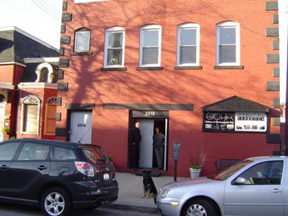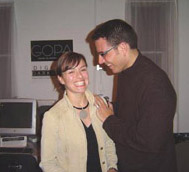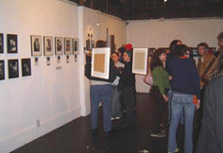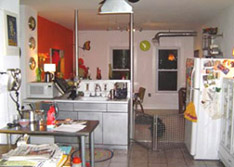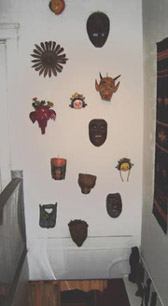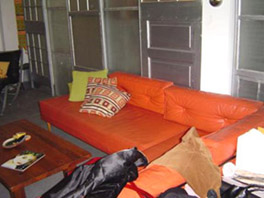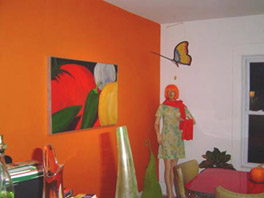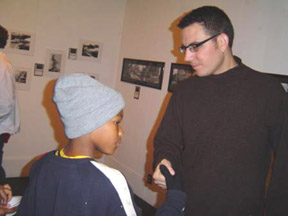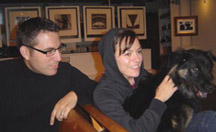


| Vol. 1, Issue 4 | |

|
Words & photos by Lindsey Bistline
Leaves swirled across the road the day before Halloween as I impatiently waited for Lolly the Trolley to move out of my way. Jammed full of tourists, it had paused in front of a red brick building with a mural painted on the side. The tour guide’s muffled voice reached me as I looked for a parking spot. I was late for a meeting in that same building, which was home to Kristien and Marina Marquez-Zenkov, and their Gallery of Photographic Arts (GOPA). Golden sunlight burst through the door of GOPA and created a gray patch on the black floor. It was the tail end of a board meeting, and cultural movers and shakers milled about looking at photographs, eating carrots from the table of snacks, and wearing sticky labels that read “Hello My Name Is”. It seemed a little incongruous when a young boy of about 11 sat down across from me and began sucking his thumb. Shortly, he was joined by two more youths arguing over some containers of film.
But the presence of children, particularly neighborhood kids, is a common sight at GOPA, which is also home to Through Students’ Eyes — a program begun by Kristien, Jim Harmon, a former video production teacher at Lincoln-West High School, and Piet Van Lier, a local photo journalist. After earning a PhD in Education at the University of Wisconsin, Kristien (then just) Zenkov moved to Seattle and began job hunting. “Seattle was beautiful and disappointing,” he says, noting that it is a generally well-off area saturated with urban planners, educators and other civic-minded people with ample resources. There wasn’t much need for more of the same. Searching for a place to satisfy the social activist side of his nature, Kristien, a Chicago native, turned his eye homeward toward the Midwest. Feeling he’d found a city where his talents could truly be put to use, he accepted a job with CSU in its education department. In October 2000, just after Kristien moved to Cleveland, the gym roof of East High School collapsed, injuring three students. Like many others, he was horrified that the schools were in such disrepair. This is what students [see] here—crumbling schools, not worth it, no one cares, he thought. It prompted him to ask students what they think of their schools and education? And so Through Students’ Eyes was born. Though it originally focused on students at Lincoln West high school, the program has expanded to include inner city elementary children as well as kids living in the public housing projects across the street. Through Students’ Eyes asks participants three questions: What is the purpose of school? What helps you succeed? What interferes with your success? They are then equipped with a camera and film to answer the questions. Students bring their photographs to GOPA, where 20 professional photographers volunteer their time to review the students’ work and talk about it with them.
“We need places that need intelligent, caring creative people,” Kristien explains, resting a hand on Marina’s thigh as he speaks. It is evident they are very much in love, bolstered by a whirlwind courtship that lead to their marriage. Their mutual respect for one another creates an aura of well-being that draws people in, so it’s no surprise that they are successful at attracting both artists and patrons to their gallery. Before GOPA, Kristien and Marina started the Creative Impetus Gallery (CIG) out of their apartment in the old Federal Knitting Mills building on Detroit Avenue. In the beginning, they exhibited artists of all mediums. But as time went by, the photography exhibits spoke to them in a way others didn’t. The subject matter seemed to fit in with the Marquez-Zenkovs’ social activist hearts in a way other mediums couldn’t touch. “Shows with photography always just felt more… natural,” Marina notes. Many of the photographs “documented the human condition, and that’s kind of what we feel art should be. All art has a purpose, and ours is a social purpose.” Marina is intimately familiar with the human condition. Growing up, she lost a parent and spent some time living on the streets around East 49th and Payne. “Art just for its’ own sake doesn’t interest us anymore,” Kristien explains. With the success of CIG, it wasn’t long before they needed more space, and they found it in an old storefront church on Church Avenue. Despite the garish décor, they knew as soon as they walked in that it was the one. But finding a bank to work with them was another story.
“The problem with the live/work movement is financing,” Marina says. She has warm brown eyes and a ready smile that fades when she recalls their difficulties finding financing. “When artists buy space, they tend to be more attracted to commercial or industrial buildings” she explains, because they provide the space needed to create art. However, many banks won’t grant home mortgage loans for buildings zoned as commercial structures. Instead they offer business loans, which typically have higher interest rates and require a larger down payment. Fortunately, the owners of the church accepted their offer contingent on them finding financing, and waited patiently while Marina and Kristien searched high and low for a bank that would work with them. Finally they discovered Wells Fargo, a bank based in California that has experience with this sort of transaction. Working through a representative in Cleveland, Wells Fargo classified the building as 51% residential and 49% commercial, and offered Marina and Kristien more reasonable loan rates and down payment options. Once the financing went through, the real fun began.
“Everybody thought we were crazy,” Marina says, recalling the mountain of work facing them when they bought the property. “We had a vision, and…it blinded us from the reality” of the hard work required to fix it up. The floor was covered in faded pink carpet. The ceilings were low and dominated by a red cross in the middle. In addition, parts of the floor were covered in tile that had to be scraped up by hand. “It was hell,” Kristien admits. But, they rolled up their sleeves and started gutting the building themselves. By October of 2001 they were able to move into the first floor, living out of boxes stacked on the pews while they renovated the second floor. “We made our bed on the altar,” Marina laughs at the memory. The second floor had been used as a rectory, prayer room, and conference center, so it was divided into many small rooms. They knocked down three walls to give it a more open feel, and turned a hallway into a furnace room. They installed the furnace, updated the current bathroom, and added another bathroom. They tore out the ceilings and installed insulation. They also added an in-law suite for Marina’s mother, who came to live with them. The result is a beautifully unique space that perfectly reflects their personalities and the life they’ve built around it. Roughly four months after they began gutting the building they moved into the upstairs, and managed to host their first show later that spring of 2002. Now, the first floor of the building is dedicated to the gallery—a wide-open space with a simple black floor, white walls, and few of the original pews. The second floor is accessible from the gallery, as well as a street entrance separate from the gallery. I follow Marina up a wide staircase decorated with masks into their loft-style living room decorated with a funky retro orange sofa and a black 50’s style lounge chair. Lime green walls and a colorful fish mobile add to the décor.
Sliding silver doors separate the living room from the bedroom, where a fluffy white dimpled comforter covers a large, low bed. Ikea-style dressers and open-faced closets complete the clean, simple, modern look. The kitchen boasts one wall of cheerful orange, which is Marina’s favorite color. A 50’s era mannequin named Diva—a wedding present from Kristien— oversees all meals while their mutt, Santi, cleans up any table scraps that happen to fall her way. A Way of Life When I ask Marina if it’s difficult to separate her work and her personal life, she pauses. She has a degree in Urban Planning, a background in ballet, and a day job working for Cleveland Councilman Joe Cimperman, but it is clear that this is her passion. She compares it to a farmer living and working in the same place, never questioning it.
“This is our personal life,” she answers.
Kristien agrees with her analogy. “We’re
growing something here,” he says, pointing to the neighborhood
kids hanging around the table looking at each other’s photos.
His meaning is clear—it’s them. “But there’s still so much more to do,” Marina is quick to add. Part of the neighborhood It is opening night of the Route 42 exhibit at GOPA. Black and white photographs documenting the transition from urban to suburban life on a single road line the white walls. Thumping techno music wafts out the open door. The gallery is crowded with young hipsters and artists mixing with various local photographers. It is a good turnout, and Kristien greets me like a groom on his wedding day. He radiates joy and happiness, and the ever-present neighborhood kids cluster around him as if he were the Pied Piper.
Later, as they are leaving, one of the boys casually says to Marina, “Bye mom.” “What did you say?” she asks, putting her hand on his arm to slow his flight into the night. “I said ‘bye mom,’” he repeats, louder, and without embarrassment. She smiles and hugs him. Though Kristien is speaking with two other boys, he notices the exchange. They leave, and he asks Marina what the boy said? “He said ‘bye mom,’” Marina replies, her smile widening. Kristien grasps her arm and they exchange a brief look before a fresh group of well-wishers surrounds them. |
|
What's Inny and Outty? Are you curious about the homes and lives of Cleveland’s creative people? Inny and Outty takes you inside some awe inspiring renovated dwellings and then expands the view to explore how they and others transform their landscapes, streets, commerce and more.
Also in this section... Ideas for a hot date on a cold night in |
![]()
![]()
Once Upon a Rustbelt | Party Center | Raw Materials | Subscribe | Urban Underpants

